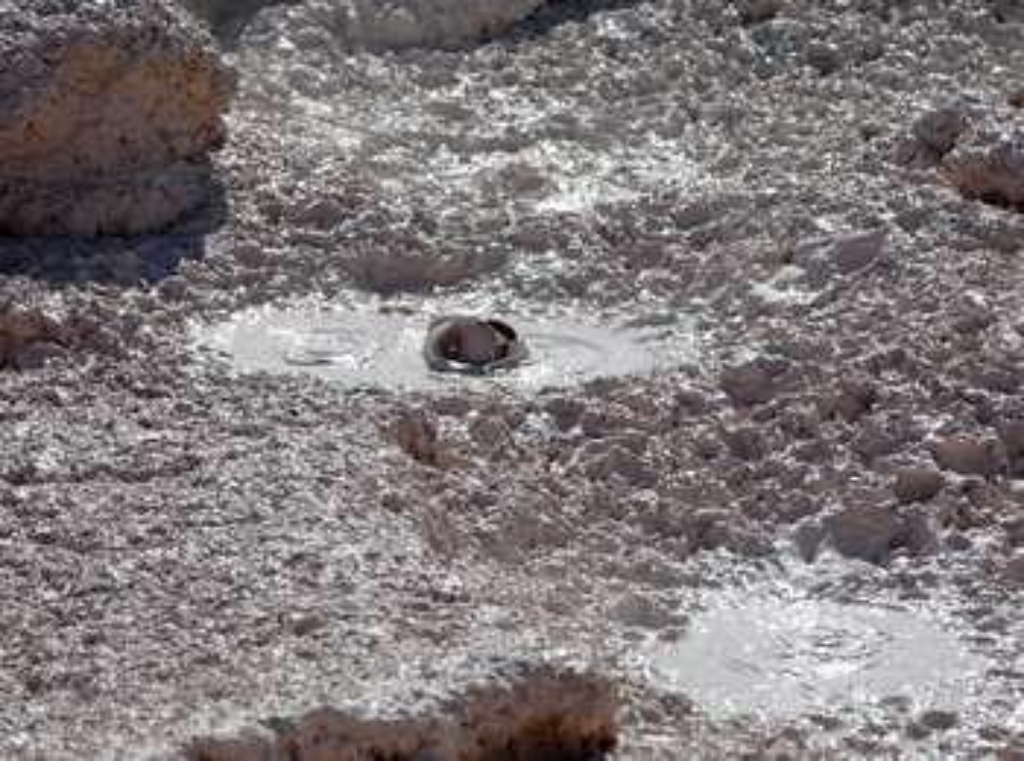
Fountain Paint Pot are affected by precipitation. In the early summer, the mudpots are thin and watery from abundant rain and snow.
By late summer they are thick. If the mud is thick, watch out! Bursting bubbles may throw mud over the rail.
The mud is composed of clay minerals and fine particles of silica. They rhyolite in this area is composed primarily of quartz and feldspar. Acids in the steam and water break down the feldspar into a clay mineral called kaolinute. The Crow tribe used to paint their tipis with this mud.
The hiss and roar of a fumarole comes from gases--steam, carbon dioxide, and a little hydrogen sulfide--rushing from the Earth through a vent. A fumarole’s channel system reaches down into the hot rock masses, but it contains very little water. When water contacts the hot rock, it flashes into steam, which increases its volume 1,500 times and drives the gases from the vent.
Mudpots
Mudpots are acidic features with a limited water supply. Some microorganisms use hydrogen sulfide, which rises from deep within the earth, as an energy source. They help convert the gas to sulfuric acid, which breaks down rock to wet clay mud and creates the area’s smell. The pungent odor of rotten eggs is caused by the hydrogen sulfide gas.
Various gases escape through the wet clay mud, causing it to bubble. Mudpot consistency and activity vary with the seasons and precipitation.
Fountain Paint Pot Area
Hydrothermal features can be grouped into two general categories: those with a great deal of water (hot springs and geysers) and those with limited water (mudpots and fumaroles). Despite their structural similarities, no two features are exactly alike. All of these features occur in the Fountain Paint Pot area.
Thermus aquaticus, the thermophile that revolutionized DNA replication processes, was discovered in this area.
Lower Geyser Basin
The Lower Geyser Basin sits on unstable glacial gravel on top of solid rock. The jarring energy of an earthquake can make the gravel vibrate and shift position, and compact or fracture.
All these changes affect water supplies to hot springs. They might force muddy water to the surface, clouding existing pools or creating new ones. They might divert water from a pool, causing it to dry up. Water temperatures might also increase or decrease due to these subsurface changes.
In the days after the Hebgen Lake earthquake of 1959, all of these changes were observed in various springs of the Firehole River geyser basins. The epicenter (point of origin) of the quake was determined to be about 31 air miles (50 km) northwest of the Fountain Paint Pots area.
Great Fountain Geyser, on the Firehole Lake Drive, is the only geyser outside of the Old Faithful area with eruption forecasts.
Use Caution in Hydrothermal Areas
- Stay on boardwalks and designated trails.
- Hydrothermal water can severely burn you.
- Never run, push, or shove.
- Supervise children at all times.
- Do not scratch hydrothermal mats.
You are responsible for your safety.
Think safety, act safely. Yellowstone is a dangerous place.
Is there something we missed for this itinerary?
Itineraries across USA


















































